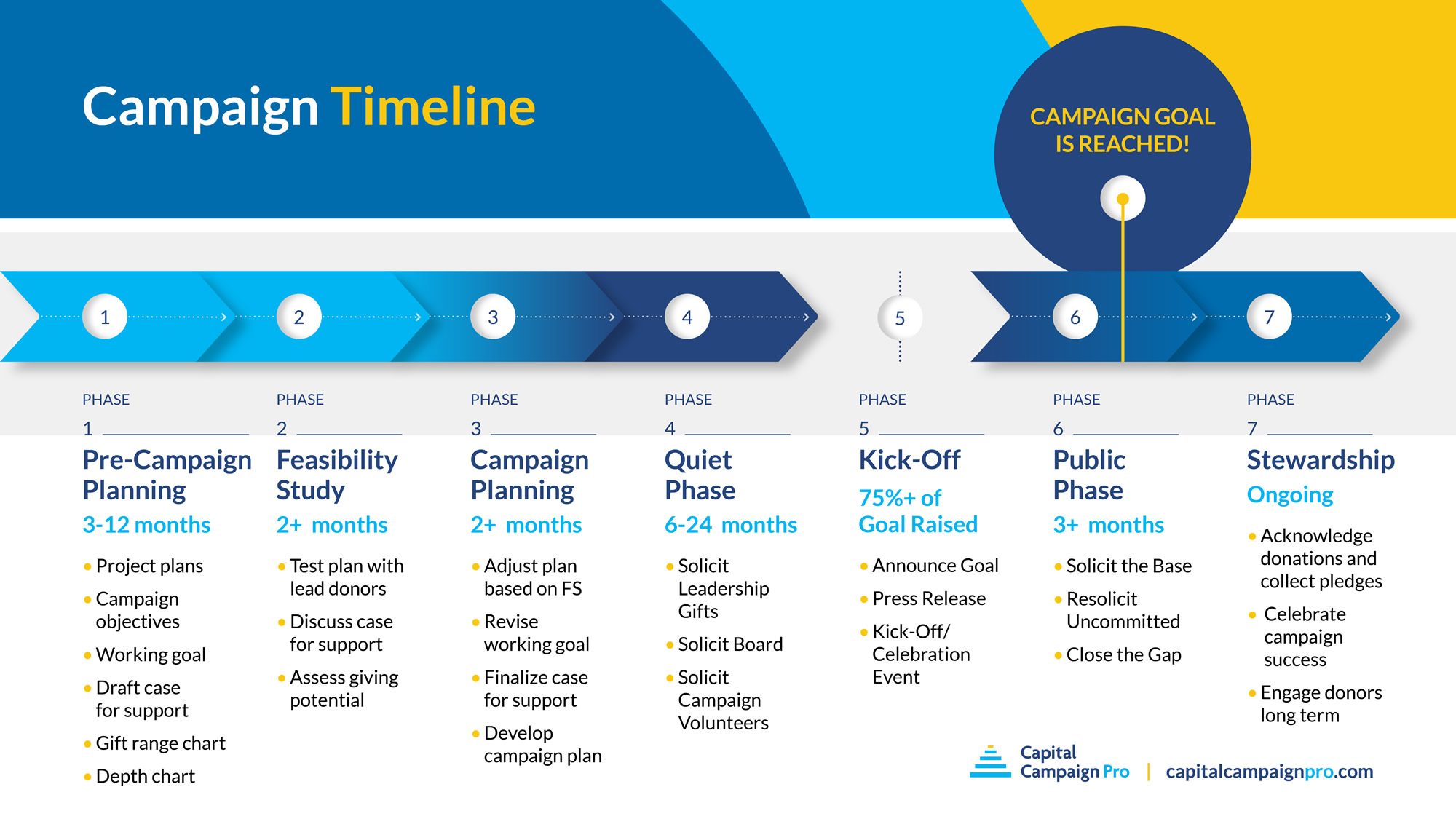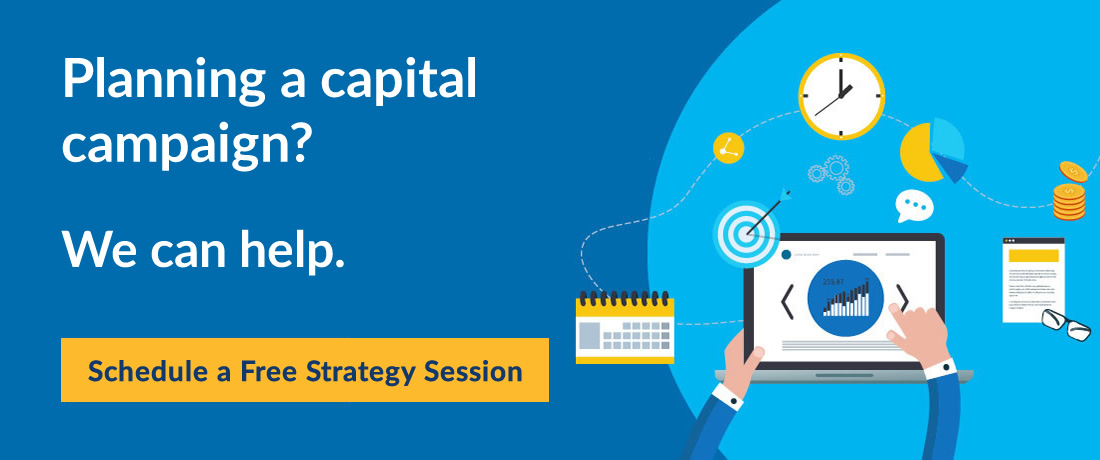Capital Campaign Planning Committees: What You Need to Know

Capital campaign committees are essential to planning, executing, and completing a successful capital campaign. Though there are several types of committees you can recruit for in a campaign, one of the most important is the campaign planning committee.
This committee will be responsible for coming together and creating your big-picture campaign plan. It is also one of the largest committees you’ll form during the campaign.
In this post, you’ll learn all about planning committees and how to use yours to set the right tone for your campaign.
- Why a Campaign Planning Committee is Important
- How to Create Your Campaign Planning Committee
- The Best Way to Enlist Your Campaign Planning Committee
- Conclusion: The Power of a Campaign Planning Committee
Please explore our complete guide to campaign committees to learn more about other types of committees and recruitment best practices!
Free Campaign Checklist & Guide
Download our free capital campaign checklist and guide to learn exactly what’s required for each phase of your campaign.

Why a Campaign Planning Committee is Important
Many capital campaigns are won or lost based on their volunteer leadership. If you have the right people heading up your campaign, you will be well on your way to success.
You’ve got to have campaign leaders who are powerful, influential, capable of opening the door to key donors, and able to make large gifts themselves.
Where will you find them? And how can you enlist them for your campaign?
While some people like that may serve on your board, you probably know of other key leaders in your community who are somewhat interested in your organization but who aren’t on your board.
Expand Your Campaign Power Base by Using a Short-Term Planning Committee
We find that many community leaders, while not interested in long-term board assignments, are quite willing to serve on a shorter-term committee to help plan the campaign strategy. And, once they are involved on the planning committee, they often become much more interested and personally invested in the campaign’s success.
A Campaign Planning Committee is distinct from a campaign steering committee. Unlike the steering committee, which meets throughout the campaign, a Campaign Planning Committee meets only two or three times over the course of a month.
That short term, but important commitment, creates a unique opportunity to invite a few special people to help shape the campaign over a couple of meetings without asking them to join a committee that will require them to participate extensively over a long period.
Involvement Yields Investment
If you can get influential people to say “yes” to this very short-term commitment, there’s a very good chance you can ask them for other things later.
Through the planning committee, they will learn more about your organization and about your campaign plans. And then after the committee’s work is done, they may be happy to open doors, advocate for the project with other community leaders, and provide advice as needed.
Catapult Your Campaign Forward
If you can assemble a small group of the most powerful, wealthiest, wisest, and most influential volunteers you have to work with you on a campaign plan, you will put your campaign on the road to success.
When those people are involved, even for just a short-term assignment, you’ll find that it will be far easier for you to attract both donors and volunteers throughout the campaign.
The planning committee concept gives you a chance to inform the most influential people in your community about your campaign, gain the benefit of their advice and wisdom, and add their names to your list of campaign volunteers.
Of course, inviting people to serve on this high-powered committee is a terrific way to cultivate them for their campaign gifts. And, if you are still looking for your campaign chair, you might find that one or two of the people who serve on the Campaign Planning Committee might step up to a leadership position if asked.

How to Create Your Campaign Planning Committee
Your Campaign Planning Committee will swing into action immediately after the feasibility or campaign planning study. The study will lead to specific recommendations made to the board about campaign objectives and goal.
Once approved by your board, you’ll be ready to plan your campaign. So that’s an ideal time to get going.

You can see in this graphic of the seven phases of a campaign, that the 3rd phase — campaign planning — is short and follows immediately after the Feasibility Study.
You might recruit some people for the Campaign Planning Committee earlier. In fact, chances are that some of them will be interviewed in the feasibility study.
And if you are doing a Guided Feasibility Study in which you are conducting the interviews, you might broach the possibility of their serving on the planning committee during the interview.
What Does a Campaign Planning Committee Do?
Over the course of two or three meetings, the committee reviews, comments on and refines the key elements of the campaign. The primary elements of the plan that the committee usually works on are these:
- Campaign objectives and working goal
- Case for support and donor discussion guide
- Gift range chart
- Lead gift prospect lists
- Campaign structure, timetable, and budget
This group should be the most powerful and influential group that your organization is able to assemble. The Committee should include community leaders, major gift prospects and a representative sample of the relevant subgroups of your constituencies, which may become separate divisions of the campaign.
The process of identifying committee members and inviting them to participate will be an important “door opener” to help gain access to a new group of influential volunteers.
Because the Planning Committee will involve individuals with varying levels of commitment to your organization, the committee’s tasks will be tightly defined and of limited duration, often just two or three meetings.
Those asked to attend the meetings will be asked to bring their experience and wisdom to the task of setting up the campaign and to lend their names to the planning effort.
How Large Should the Committee Be?
Planning committees vary in size roughly from 8 to 14. The smaller size will be easier to work with and encourages greater individual participation. But a larger group will allow you to have broader representation and expand your power base.
While it is easier for the executive director and board chair to select and recruit the people to serve on the Campaign Planning Committee, you may find it more effective to assemble a small group of powerful people to help recruit the rest of the committee members.
Although this takes time, a small group of influential people can be very helpful in determining the membership of the Campaign Planning Committee. They are likely to know other influential people and will, by their early involvement, make it more likely that others will agree to serve.

The Best Way to Enlist Your Capital Campaign Planning Committee
Enlisting the members of the planning committee is one of the most important steps in your campaign. You will want to identify and enlist the very best people for the job.
Be sure to invite some people who themselves have the potential to be major doors, and people who are knowledgeable about the organization and committed to it.
You may find that your community has a small group of people who give generously to many organizations. You may see their names pop up on campaign committees and on the top levels of donor lists.
In fact, if you’ve been part of your community for a while, you may know some of them. And chances are good that they will know others.
So start by talking to some of the philanthropic leaders you know in your community and get them to help you identify others. Whether or not they serve on your Planning Committee, you will have an excellent opportunity to get to know them.
How to Recruit Your Planning Committee
Determine the date and time of the initial meeting before enlisting the members of the capital Campaign Planning Committee.
Plan to ask your prospective members at least 4 to 6 weeks ahead of the initial meeting. The longer the intervening period, the better your response will be.
You will also want to schedule the other committee meetings. Typically, these meetings would be conducted over 2 to 4 weeks. The timetable for these meetings needs to be tight enough to create a sense of urgency and accomplishment, but also provide enough time between meetings to refine planning documents.
To help recruit the members, write all of the relevant information about the purpose of the meetings and the dates and times in a clear, concise document to present to them at the beginning of the process.
Responsibilities of a Campaign Planning Committee
A document that outlines the responsibilities of the committee will be helpful as you recruit participants and prepare for the meetings. Below is a sample that you can adapt.
Sample Charge to the Campaign Planning Committee
The Campaign Planning Committee will plan a special fundraising campaign to:
- Campaign objective 1
- Campaign objective 2
- Campaign objective 3, etc.
Committee members will take part in 2 or 3 campaign planning meetings. The recommendations resulting from these meetings will form the basis of a planning document, which will guide the fundraising campaign.
This document will include:
- A statement of campaign objectives and a case for supporting those objectives.
- A recommended working goal for the campaign and a table of gifts showing the number and size of gifts needed to reach that goal.
- A donor recognition plan.
- A campaign timetable.
Names of the members of the Campaign Planning Committee will be listed, along with board and campaign steering committee on assorted campaign materials.
Recruiting Planning Committee Members
Invitations to join the committee will be as carefully planned as asking the prospect for a gift, because the invitation will serve as the first step toward a campaign gift and/or additional roles in the campaign. It’s important to find the right time and place to ask someone to agree to serve on the committee.
These invitations should be offered in a private setting where frank discussion can take place and the person being enlisted can accept or decline without broader consequences.
Each committee member will be asked to serve in order to:
- Provide feedback regarding XYZ’s case for support and campaign plans.
- Make recommendations regarding the key elements of the campaign plan including the goal, timetable, and practices.
Capital Campaign Planning Committee Sample Invitation Letter
Once you’ve gotten your material together and decided who to invite to your Campaign Planning Committee, the next step is figuring out how to invite them.
Here’s a sample letter of invitation used for an actual capital campaign a few years ago. You might find it helpful to see how she framed the Campaign Planning Committee’s work in this letter:
Sample Letter of Invitation
As a XYZ County leader, your opinion is important to XYZ Community College. We invite you to join 10 to 15 community leaders at a special meeting to offer your advice and expertise regarding the College’s future plans.
We will meet January 11 from 4:30 p.m. to 6:00 p.m. at the XYZ Country Club. Light refreshments will be served.
You are probably aware that within the next five years, XYZ County’s expanding health care industry will demand many new professionals trained in state-of-the-art medical care. XYZ Organization provides more than 200 well trained health care graduates/ workers each year and still cannot meet the current employment demands of local employers.
The XYZ Foundation is planning a capital campaign to expand our health careers educational facilities and programs, upgrade technology to keep our programs up to date, expand our endowments for educational scholarships for students, and provide professional development for our faculty.
We are asking you to serve on a short-term Capital Campaign Advisory Committee to help us with the following:
- Reviewing our vision statement for this campaign and provide your feedback
- Reviewing our list of 30-40 community representatives to participate in a feasibility study for this campaign
- Providing recommendations about our plan and process
- Reviewing the results of the feasibility study when it is completed and make suggestions
This committee will meet twice: First on January 11 to review our proposed plan and offer feedback, and again on February 2 to review the results of the feasibility study and develop recommendations for our board of trustees regarding the capital campaign.
We consider your participation and your advice as important investments in the success of XYZ Community College’s ability to provide more well-trained graduates for our local workforce.
I will contact your office next week to answer any questions and confirm your participation.
[Signature]
This letter has a formal style that may or may not work for you. But whatever style you chose, the content of your letter should be similar.

Conclusion: The Power of a Campaign Planning Committee
You may think, reading all of this, that it’s a more work than it’s worth to have a Campaign Planning Committee. And it does take effort. But inviting the leaders of your community to become involved at a high level in planning your organization’s campaign often yields remarkable long-term results.
Here are just a few:
- You will deepen your relationship with your community’s leaders.
- The philanthropic leaders of your community will become more engaged in your organization and your plans for the future.
- When powerful people become involved in your campaign, the board and donors will have increased confidence that the campaign will be successful.
- And, long after the campaign is over, the relationships you developed with those community leaders will persist!
Don’t take the easy road as you plan your campaign. Grasp the opportunity to use the campaign planning process to catapult your organization forward and build a ramp to success.
Tips for Creating Your Campaign Planning Meeting
Keep these three key items in mind as you build your Campaign Planning Meeting:
- Think big and be courageous. Use your Campaign Planning Committee to catapult the power and reach of your organization beyond what you might currently believe is possible. You have an opportunity with your campaign to involve people who can help chart a different course for your organization. Don’t miss it.
- While the Campaign Planning Committee is short-term, usually meeting only two or three times, it can have an outsized effect on the success of your campaign. So it’s worth your time and attention to get it right.
- When you recruit members for that group, you must be clear about what you are asking them to do. Develop a plan for the committee and then recruit the members. And when you do, recruit the most powerful people first. They will then help you attract the rest.
Be brave and courageous. Be well-organized and clear. And watch what happens.
A special thanks to Gail Perry, who wrote a series of posts on this topic from which this post was adapted.




Leave a Comment